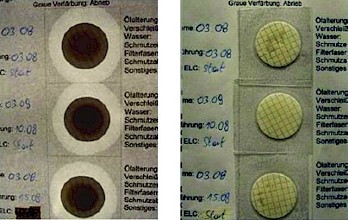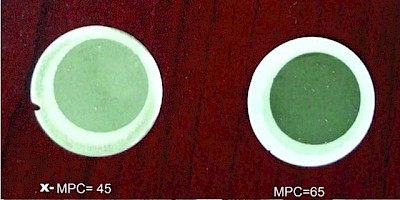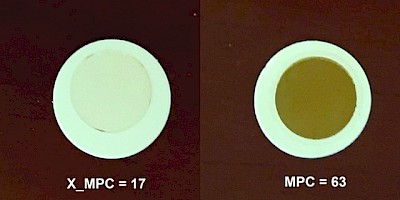Deficiencies of membrane patch colorimetry (MPC) test: The Varnish Potential Test
API Group II oils have been commonly used in gas turbines during the past two decades. As a result, varnish contamination has been one of the most concerning problems for those who maintain them. These contaminants are sludge-like and sticky compounds that are the result of interactions of phenol and amine antioxidants in the oil environment. The high solubility of varnish at different lubricant temperatures makes varnish contamination a complicated problem to tackle. Because of this, gas turbines may experience numerous technical difficulties.
 Currently, the most common laboratory test for detecting varnish potential in the oil is the membrane patch colourimetry (MPC) test (ASTM D7843). Despite its overall value, it still suffers from some shortcomings. Understanding these shortcomings helps analysts prevent otherwise probable errors and mistakes.
Currently, the most common laboratory test for detecting varnish potential in the oil is the membrane patch colourimetry (MPC) test (ASTM D7843). Despite its overall value, it still suffers from some shortcomings. Understanding these shortcomings helps analysts prevent otherwise probable errors and mistakes.
The Current Testing Method
ASTM D7843 is intended to estimate the amount of risk that varnish contamination poses to gas turbine performance. According to this standard, the oil sample should first be kept at about 65° C for 24 hours prior to the test and then left for about 72 hours at 20° C. Then a certain volume of the oil sample is diluted by a non-polar solvent such as petroleum benzene and passed through standard membranes with 0.45-micron pore size.
Depending on the amount of varnish contamination in the oil, the standard white membrane will discolour to varying degrees. The intensity of the colour created on the membrane is measured by a spectrophotometer and a number ranging from 0 to 100 (in rare cases even above 100) will be assigned as an indicator of varnish potential.
Despite the valuable results of this standard, there are some shortcomings in current practice. This article will address two of these weaknesses, as noted by two international experts.
Observations on the current testing method
In 2014 Professor Akira Sasaki authored an article pointing to a major flaw in the ASTM D7843 standard.
Since the spectrophotometers recommended in this standard are not designed to address the specific needs of the test, a significant portion of the varnish sub-micron particles trapped inside the membrane volume is not visible and is often missed during measurement.

and transmitting light
As you see in Figure 1, the intensity of the colour when the membrane is lit from the back leads to different results when compared to the way it looks when lit from the front.
In 2015, Professor Sasaki developed a new colourimetric patch analyzer (CPA) which can measure the colour of contaminants on the patch surface using reflected light and the colour inside the patch by using transmitted light.
One of the most common concerns when using a solvent to dilute in a lab test is that the solvent may dissolve part of what is to be measured and distort the test results.
In 2014, Andy Sitton presented a new index in order to address this concern in Machinery Lubrication magazine.
In Sitton's method, the volume of the oil sample is passed through membranes in accordance with ASTM D7843, but no solvent is used. Although the proposed method can take considerable time because of the need to pass thick oil through the membrane, it will eliminate the possible effects of the solvent.
The varnish potential is obtained by using a solvent in the ASTM D7843. Sitton's new index is also measured by a spectrophotometer and is called iMPC. The final index will be the number obtained from the division of iMPC into MPC.
The closer the index is to the unit, the more likely it is to deposit varnish on the interior surfaces of the turbine and the greater risk it poses to its safe operation.
Soluble and insoluble varnish contaminant:
The results from the ASTM D7843 standard do provide a useful index but do not provide distinct estimates of the probable volumes of soluble and insoluble varnishes. Because of the 72-hour oil retention time required by the ASTM D7843 and the agglomeration phenomenon, soluble varnish particles are instead added to the volume of insoluble varnish in the sample and their total volume is then measured.
However, doing so disregards the fact that the hazardous effects of oil-soluble varnish contamination are far greater than those of oil-insoluble varnish. The soluble varnish will be able to circulate further, reaching the smallest openings and clearances of control valves due to its solubility in oil. Then, as the oil temperature drops for any reason, the varnish particles join together and are dissolved into the oil. The resulting viscous sludge mass can easily interfere with the normal operation of the turbine and even cause sudden stops. In addition, the accumulation of these contaminants in the turbine can cause serious damage to mechanical parts such as bearings (4).
If a comparison can be made between the volume of soluble and insoluble varnish present in the lubricant, an estimate of the actual hazards in the gas turbine can be more accurately determined. In the following method, an index will be introduced that can measure oil-soluble varnish and insoluble varnish separately and its benefits will be examined more closely.
The procedure for measuring soluble and insoluble varnish
- In accordance with the instructions given in ASTM D7843, the oil sample is kept at 65° C for 24 hours.
- The first patch test will then be performed. Since only the insoluble varnish present in the oil can be identified at this stage, the results indicate the insoluble varnish present in the oil.
- Then the oil sample is kept at about 20 ° C for 72 hours.
- The second patch test is then performed, and both membranes are evaluated via spectrophotometer.
- The result obtained from the first membrane is the index of the insoluble varnish present in the oil sample (X_MPC)
- The result obtained from the second membrane is the sum of the soluble and insoluble varnish present in the oil sample (MPC).
Evaluating results:
With the aid of the oil insoluble varnish index (X_MPC) and the soluble and insoluble varnish sum index (MPC) the R index value can be determined according to the formula below:
R = MPC + (5 - X_MPC)
It should be mentioned that 5 units have been added to the formula to help eliminate the effects of new oil colour on a standard membrane.
Now that R has been determined, it is possible to eliminate insoluble particles from the test results providing a more relevant measurement of real-world risk. If R is less than 15, the turbine conditions are acceptable. From 15 to 30, turbines should be monitored continuously, and if more than 30, turbines are in an abnormal or critical condition and require immediate action. Solutions for cleaning up the varnish in affected gas turbines are a topic for another article.
Fields practical observations:
What prompted me to introduce a new index was my experience dealing with the different effects of the contaminants discussed in this article despite relatively similar MPC results.

As shown in Figure 2, the varnish potential of the turbine oil employed in a petrochemical plant is MPC = 65. Another example shown in Figure 3 is a turbine working in a thermal power plant, showing a varnish potential of MPC = 63.
Although both oil samples appear to be at high risk of varnish contamination, the calculation of the R index indicates that the oil used in the thermal power plant turbine has a higher risk. Here is what this method of testing looks like in practice:
Calculation of Varnish Index R1 for Petrochemical Plant gas turbine. R1 = MPC + (5 - X_MPC) = 65 + (5 - 45) >>> R1 = 25
Calculation of R2 Varnish Index of Thermal Power Plant gas turbine. R2 = MPC + (5 - X_MPC) = 63 + (5 - 17) >>> R2 = 51

The MPC value for both samples are nearly identical and both appear to indicate serious risk. In fact, because of the higher amount of oil-soluble varnish in the second sample, the probability of sediment contamination is higher at the critical points within the second gas turbine at the thermal power plant.
Importance of particle counting report:
Most oil labs currently use laser particle counters calibrated in accordance with ISO4406:99 to count suspended particles within the oil. In this standard, only suspended particles larger than 4 microns are examined and counted. Field observations have shown that high contamination of turbine oil with particulate matter can contribute to profound errors in MPC varnish potential test results.
Therefore, it is important to consider particle counts when evaluating MPC values. Clearly, calculating the R index and thus removing insoluble particles from the varnish potential test results can be of great value to analysts.
Conclusion:
Though this article is a critique of deficiencies in the ASTM D7843 standard, it is still available and viable as a powerful and reliable tool. Analysts' attention to the test results and the issues mentioned in this article can help to mitigate misunderstandings and errors in the final analysis. Focusing only on the numerical value of MPC tests can be misleading and could lead to costly, inaccurate and ineffective decisions.
The smart choice is to supplement your particle counting results with the R index presented here in order to ensure a useful analysis of MPC value.
References
- Dr. A. Sasaki, CPA newsletter (October 2015)
- US Patent NO. 8,390,796B2 (Mar. 5, 2015
- Andy Sitton, Focuslab.
- Machinery Lubrication Magazine. (6/2014)
- The varnish issue: strategies for successful monitoring and acceptable level.
- Dr. H. Tubisu. Dr. A. Sasaki.
- Review of varnish problems of modern gas turbines.
- Society of tribologists and lubrication engineers annual meeting. (2010)
